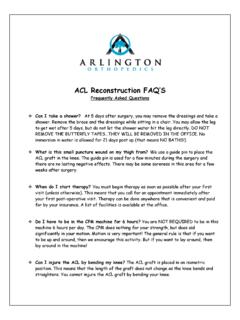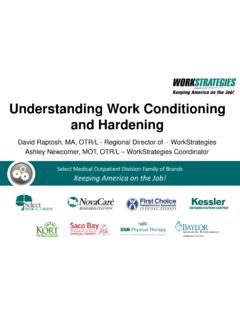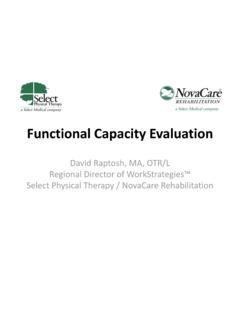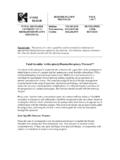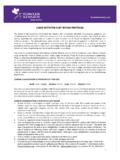Transcription of After Arthroscopic Subacromial Decompression …
1 After Arthroscopic Subacromial Decompression intact rotator Cuff (Distal Clavicle Resection). Rehabilitation Protocol Phase 1: Weeks 0-4. Restrictions ROM. 140 degrees of forward flexion 40 degrees of external rotation 60 degrees of abduction ROM exercises begin with the arm comfortably at the patient's side, progress to 45 degrees of abduction and eventually 90 degrees. Abduction is advanced slowly depending on patient comfort level No abduction or rotation until 6 weeks After surgery. This combination re-creates the impingement maneuver No resisted motions until 4 weeks postoperative (No cross-body adduction until 8 weeks postoperatively if distal clavicle resection).
2 Immobilization Early motion is important Sling immobilization for comfort only during the first 2 weeks Sling should be discontinued by 2 weeks After surgery Patients can use sling at night for comfort Pain Control Reduction of pain and discomfort is essential for recovery Medications Narcotics-10 days-2 weeks following surgery NSAIDS for patients with persistent discomfort following surgery Therapeutic modalities Ice, ultrasound, HVGS. Moist heat before therapy, ice at end of session Motion: Shoulder Goals 140 degrees of forward flexion 40 degrees of external rotation 60 degrees of abduction Exercises Begin with Codman pendulum exercises to promote early motion Passive ROM exercises Capsular stretching for anterior, posterior, and inferior capsule, using the opposite arm Active-assisted ROM exercises Shoulder flexion Shoulder extension Internal and external rotation Progress to active ROM exercises as comfort improves Motion.
3 Elbow Passive-progress to active 0-130 degrees Pronation and supination as tolerated Muscle Strengthening Grip strengthening with racquetball, putty, Nerf ball Phase 2: Weeks 4-8. Criteria for Progression to Phase 2. Minimal pain and tenderness Nearly complete motion Good shoulder strength 4/5 motor Restrictions Progress ROM goals to 160 degrees of forward flexion 45 degrees of internal rotation (vertebral level L1). Immobilization None Pain Control NSAIDS for patients with persistent discomfort Therapeutic modalities Ice, ultrasound, HVGS.
4 Moist heat before therapy as needed at week 6, ice at end of session Subacromial injection: lidocaine/steroid-for patients with acute inflammatory symptoms that do not respond to NSAIDS. Motion Goals 160 degrees of forward flexion 60 degrees of external rotation 80 degrees of abduction 45 degrees of internal rotation (vertebral level L1). Exercises Upper extremity ergometer (an instrument for measuring the amount of work done by human muscles). Increasing active ROM in all directions Focus on prolonged, gentle passive stretching at end ranges to increase shoulder flexibility Utilize joint mobilization for capsular restrictions, especially the posterior capsule Muscle Strengthening rotator cuff strengthening (only three times per week to avoid rotator cuff tendinitis).
5 Begin with closed-chain isometric strengthening Internal rotation External rotation Abduction Progress to open-chain strengthening with Therabands Exercises performed with the elbow flexed to 90 degrees Starting position is with the shoulder in the neutral position of forward flexion, abduction, and external rotation (arm comfortably at the patient's side). Exercises are performed through an arc of 45 degrees in each of the fives planes of motion Six color-coded Theraband bands are available; each provides increasing resistance from 1 to 6 pounds, at increments of one pound Progression to the next band occurs, usually in 2- to 3-wk intervals.
6 Patients are instructed not to progress to the next band if there is any discomfort at the present level Theraband exercises permit both concentric and eccentric strengthening of the shoulder muscles and are a form of isotonic exercises (characterized by variable speed and fixed resistance). Internal rotation External rotation Abduction Forward flexion Extension Progress to light isotonic dumbbell exercises Internal rotation External rotation Abduction Forward flexion Extension Scapular stabilizer strengthening Closed-chain strengthening exercises Scapular retraction (rhomboideus, middle trapezius).
7 Scapular protraction (serratus anterior). Scapular depression (latissimus dorsi, trapezius, serratus anterior). Progress to open-chain scapular stabilizer strengthening *Note: Do not perform more than 15 repetitons for each set, or more than three sets of repetitions. If this regimen is easy for the patient, then increase the resistance, not the repetitions. Upper body strengthening with excessive repetitions is counterproductive. Phase 3: Weeks 8-12. Criteria for Progression to Phase 3. Full painless ROM.
8 Minimal or no pain Strength at least 50% of contralateral shoulder Stable shoulder on clinical examination-no impingement Goals Improve shoulder strength, power, and endurance Improve neuromuscular control and shoulder proprioception Prepare for gradual return to functional activities Motion Achieve motion equal to contralateral side Utilize both active and passive ROM exercises to maintain motion Muscle Strengthening Advance strengthening of rotator cuff and scapular stabilizers as tolerated Eight to 15 repetitions for each exercise.
9 For three sets Continue strengthening only three times per week to avoid rotator cuff tendinitis from overtraining Functional Strengthening Plyometric exercises For Patients with Concomitant Distal Clavicle Resection Now begin cross-body adduction exercises First passive, advance to active motion when AC joint pain is minimal Phase 4: Weeks 12-16. Criteria for Progression to Phase 4. Full, painless ROM. No pain or tenderness Shoulder strength that fulfills established criteria Satisfactory clinical examination Goals Progressive return to unrestricted activities Advancement of shoulder strength and motion with a home exercise program that is taught throughout rehabilitation Progressive, Systematic Interval Program for Returning to Sports Throwing athletes Tennis players Golfers Institute Thrower's Ten program for overhead athlete Maximum improvement is expected by 4-6 mo following an acromioplasty.
10 And 6-12. following an acromioplasy combined with a distal clavicle resection Warning Signals Loss of motion-especially internal rotation Lack of strength progression-especially abduction Continued pain-especially at night Treatment of above Problems . These patients may need to move back to earlier routines May require increased utilization of pain control modalities as outlined above If no improvement, patients may require repeat surgical as outlined It is important to determine that the appropriate surgical procedure was done initially Issues of possible secondary gain must be evaluat

